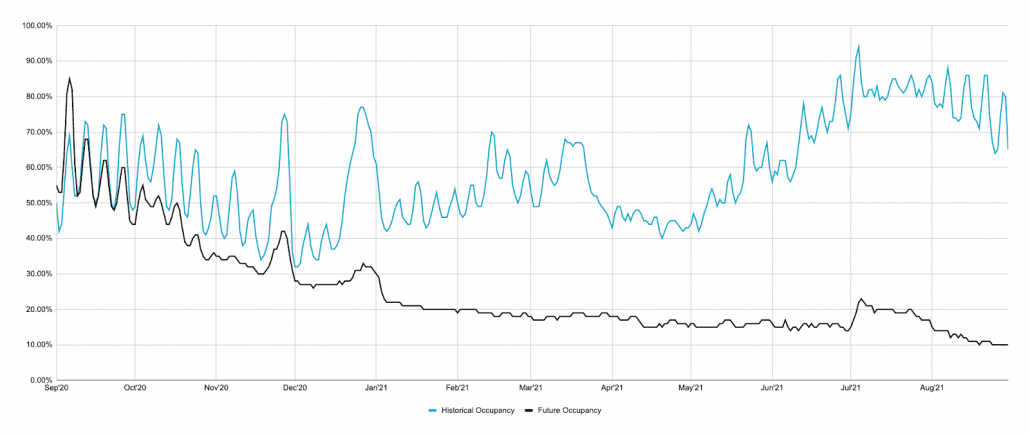At the end of the day, the thing that matters most for your hospitality business is revenue. The ability to set the right price at the right time is integral to your property performance, directly affecting bookings and your bottom line.
What exactly is revenue management? According to short-term rental data experts Transparent, ‘Revenue management is the method of using analytics to examine availability and price, and predict guests’ behavior with the aim of maximizing revenue.’
In simple terms, revenue management is how you make the most money out of your listings. You need to find that “Goldilocks Zone” of pricing – high enough to generate revenue, while low enough as to not discourage guests. So revenue management is the art of getting your pricing just right.
When done successfully, a revenue management strategy can transform your business and allow you to:
- Make more money on each listing.
- Minimize the risk of cancellations or fraud.
- Save more time by automating processes to reduce manual work.
- Consider more factors like demand, market trends, and unexpected events.
Creating your revenue management strategy: introducing the pyramid
To help you build the best revenue management strategy for your business, the Guesty team like to think of revenue management as a pyramid. Each layer builds on the previous, and becomes another element of your strategy.

The more layers you add to your pyramid, the higher your potential revenue becomes. But adding more layers also requires a deeper understanding of revenue management, and takes more work to do.
Let’s dive into the different layers of this pyramid.
Base price
The foundation of the pyramid is the base price. This is the default ideal price for a single night stay before any number crunching or external factors are brought into play. Essentially, the base price asks, “What is this listing worth?”

As with a standard property, this depends mostly on fixed factors like the number of rooms (bedrooms, bathrooms, kitchens, etc.), proximity to the city center or public transportation, whether it has a garden or balcony, and more.
Of course, fixed factors are – by definition – fixed, meaning that you can’t change the location of your property, for example.
So what can you do to optimize your foundation and increase your base price, beyond these fixed factors?
Amenities: the secret ingredient
Adding permanent amenities is a fantastic way to increase your base price, and set you on the way to a higher nightly rate. While purchasing amenities has the obvious upfront cost associated, the premium that you can charge for some of them can end up paying for itself in a matter of months.

Based on research from our pricing partners, Beyond, hot tubs and swimming pools have emerged as clear winners. Vacation rentals with these amenities can charge a 20-25% premium above similar listings without.
Layer one – dynamic pricing or rate strategies
The first layer of the revenue management pyramid gives two possible roads to go down. You can do it with rate strategies (manually) or let machine learning do it for you with dynamic pricing. It’s important to explore both options before deciding what’s best for your business.
Dynamic pricing
Dynamic pricing is a machine learning tool that provides pricing updated daily based on changes in supply and demand within the market. The idea is that market demand is highly dynamic, and no two days are the same. Daily demand can vary based on days of the week, seasonality, local (or even hyperlocal) events, market trends, competitor pricing, and more.

A dynamic pricing tool takes all this market data into account to give you the optimized price for your listing, 365 days of the year.
Benefits of dynamic pricing:
- Save time and stress – Calculating a nightly rate that considers all of the factors that affect daily demand can be a nightmare. A dynamic pricing tool will do this automatically
- Maximize revenue – Ensures your price point is high enough to maximize revenue but low enough to still get plenty of bookings
- Retain control – While you receive a pricing recommendation for each day of the year, you can still fine-tune and tweak specific dates to better meet your business goals. Plus, set minimum and maximum limits for your nightly rates so pricing always remains within your specified range
Rate strategies
The other option is to set your nightly rates manually. Essentially, this allows you to translate your pricing strategy into your Property Management Software (PMS). It works by creating a set of adhoc rules for your pricing strategy.
For example, one rule could be to increase nightly rates by 20% on weekends compared to weekdays. These rules can be designed to consider all the same factors that dynamic pricing tools consider, but require a degree of knowledge and expertise to get right. Some common rules consider seasonality, competitor pricing, days of the week, local events, and more.

Setting these rules is more work, but is budget friendly as you’re not paying for a pricing tool to do it for you.
Benefits of rate strategies
- It’s free – You can set up your rate strategy from your existing PMS tool.
- Capitalize on your expertise – If you’re a short-term rental expert, it’s a great way to translate deep industry knowledge and an understanding of market trends into an even more effective pricing strategy than what a machine can create.
Layer Two – Rate plans
The second layer of the pyramid is rate plans. These increase bookings by offering guests different offerings (and therefore pricing options) for the same listing. Additionally, this is a great opportunity for upsells.

Options for rate plans include:
- Flexible cancellation policies – In these uncertain times, these are becoming more and more valuable to guests, and offering flexible cancellation at a small fee is a great way to make a bit of extra cash.
- Extra beds – Families traveling with multiple kids may want to put an extra bed or two in one of the rooms, and are happy to pay more for this service.
- Meals – Depending on the property, offering to include certain meals is another great way to increase the price of the listing.
- Amenities – While some amenities are part of the furniture of the household, others can be added for a certain price. Offering bike or electric scooter rentals, or even kayaks or paddle boards for listings near water are all great options. This also feeds into the growing industry narrative that ‘the property is the experience’, and providing a memorable guest experience is a great way to increase direct bookings.
Layer Three – Discounts, promotions, and coupons
Layer three is the icing on the revenue management cake. You’ve got the fundamentals of your pyramid in place – now it’s time to target potential guests.
Discounts, promotions, and coupons are excellent marketing tools. They are the ace up your sleeve that you can use to ensure you meet your business goals. They can be used to bring more guests into a lower-performing property, or during low season to tempt guests into a cheaper getaway.

With an effective property management software like Guesty, you have the option of creating coupons for both online travel agencies and direct booking channels. This allows you to bring more guests into your properties with attractive, short-term promotions that appear on all your channels. You can also set up promotions based on how long the guest is staying and showcase how much they will save when they book.

Some ideas of what you can offer:
- Early or late bookings – Offer discounts for booking early, or last minute coupons to ensure your listings stay busy year round.
- Long stay discounts – Offer discounts for guests staying in the mid-term. This is a great way to lock in revenue during lower seasons and caters to the growing trend of people staying longer at short-term rentals, as well as to digital nomads looking to combine work and play.
- Event-specific promotions – Offer promotions around specific sports or live music events
Final Thoughts
Having a revenue management strategy in place is essential to running a successful short-term rental business. It allows you to make more money at each layer of the pyramid, while fitting into part of a larger revenue management system.
Looking to learn more about revenue management? Check out our virtual webinar on Navigating Uncertain Times with Revenue Management




